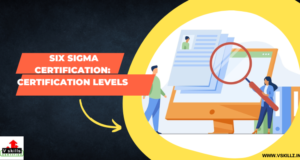Introduction
The Six Sigma methodology is the universal system of professional operations, quality control and business strategies, and it’s a largely effective system of managing large and complex processes within businesses and associations. Professionals who use the Six Sigma methodology frequently pursue advanced situations of instrument, which end with the Black Belt and Master Black Belt situations, to come up with expertise in process capabilities, statistical propositions, hypothesis training and business analysis. Understanding what a Black Belt is and how you can get it may help you decide whether this instrument can advance your career.
What is Black Belt in Six Sigma?
A Black Belt certification in Six Sigma is the expert position of the training methodology, which is a data- driven, design operation system that focuses on data and statistics to measure effectiveness, productivity and the success of colorful company processes. Professionals working in IT, statistics, and analysis often employ Six Sigma methodologies to assess business efficiency using quantitative metrics. A Black Belt instrument indicates a director’s expert position in creating advancements and streamlining operations in design operation, business analysis and functionality.
To come a certified Black Belt, professionals progress their way through the varying belt situations. Progressing from the Green Belt, individuals who attain a Black Belt in Six Sigma acquire a more profound comprehension of its principles and become adept at making crucial business decisions. The journey commences with a White Belt, which serves as an introductory level for individuals showcasing basic production skills, followed by the Yellow Belt, indicating their grasp of the program’s concepts.
Certifications and Requirements for Six Sigma
Black Belt training teaches professionals about methodologies for business transactions, while Master Black Belts can lead long-term business transformation activities. These are the criteria one must fulfill to achieve a Black Belt certification.:
- Gain a Green Belt certification
2. Have a minimum of three times of full- time professional experience
3. Gain work experience in a core knowledge area
4. It is necessary to apply all Six Sigma functions while successfully completing a minimum of two Six Sigma projects.
5. Develop Moxie in generating advancements by applying multivariate criteria
6. Be a proven leader in process problem- working and suitable to train or trainer design brigades
7. Devote all time to Six Sigma prosecution and special tasks
To become a Master Black Belt, you have to meet these requirements:
- Gain Black Belt certification
2. Have a minimum of five times of full- time employment or be part of at least 10 Six Sigma projects
3. Coach Green and Black Belts in their process of change and development
4. Work as an internal adviser and continue as an in- house trainer
5. Develop your own business strategies and crucial criteria to use in confluence with Six Sigma
6. Guarantee you constantly apply Six Sigma to all job functions in all departments
7. Devote all time to statistical tasks, such as identifying additional projects/functions
8. Have a portfolio of your work that shows your expertise
Training methodology for Six Sigma
Black Belt training in the Six Sigma methodology focuses on the product and manufacturing side of a company using two main generalities, the DMAIC, which focuses on the requirements of the company, and DMADV, which focuses on the requirements of the client. In the Six Sigma process, the Black Belt becomes an expert in both. Here are some facts and information about the DMAIC and DMADV generalities.
DMAIC
This is the data- driven methodology of Six Sigma to ameliorate being products and processes, and it stands for define, measure, dissect, ameliorate and control. The defining stage establishes the process you want to probe and probe to ameliorate, and the measuring step is determining the parameters to compare through data and other criteria . Analysis is when you develop results and advancements as a thesis to test, followed by advancements you apply to increase the effectiveness and product of your company’s pretensions. Eventually, the control state is when you develop a process to continually review, measure and ameliorate the new process.
DMADV
This is the design part of Six Sigma processes that motivates the design or redesign of manufacturing processes, and it stands for define, measure, dissect, design and validate. Defining is relating the guests’ requirements when developing or perfecting products. The measuring step collects data, behavior
and satisfaction situations of your customers. By developing these criteria , you can classify areas for enhancement, progress and failures.
assaying conditioning includes a study of the data and criteria to determine products and services that need enhancement. Next is the design stage, which is where you develop a business model and process that meets company pretensions and customer needs. Eventually, you validate to confirm the changes in customer needs and continue perfecting the process.
Benefits Of Earning Black Belt in Six Sigma
Acquiring a Black Belt certification offers numerous advantages. As the Six Sigma philosophy and its applications are intricate, each level attained demonstrates the capacity to develop new skills and consistently apply fresh concepts. Some key benefits of earning a Black Belt in Six Sigma comprise:
- Increases job opportunities: Professionals with an advanced credential, similar as the Six Sigma Black Belt, frequently can expand their job prospects to upper- operation and elderly places and qualify for advanced- position elevations.
- Boosts earning potential: Six Sigma Black Belt experts may earn advanced hires than professionals at the white, yellow and Green Belt certifications.
- Promotes leadership growth: The Black Belt certification equips professionals with the skills needed to lead teams in implementing Six Sigma’s concepts, methods, and tools.
- Enhances proficiency in tools and methods: The Six Sigma Black Belt training delves into intricate subjects that build upon the foundation established in previous Six Sigma levels.
- Fosters innovation: New capabilities can help you develop strategies to produce and apply new inventions to ameliorate your team’s productivity.
Conclusion
Along with the experience, you need some more qualities to become Six Sigma Black Belts. Which is innovative thinking, ability to understand the customer requirements and expectations, effective communication, management, and leadership skills to produce tangible financial results for the business. So if you feel it’s the right stage for you to attain black belt in six sigma, go for it and achieve the certification.



